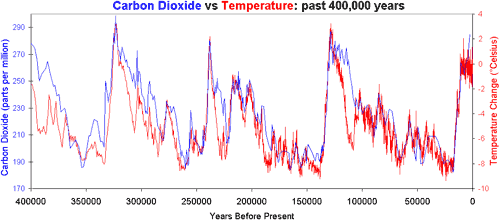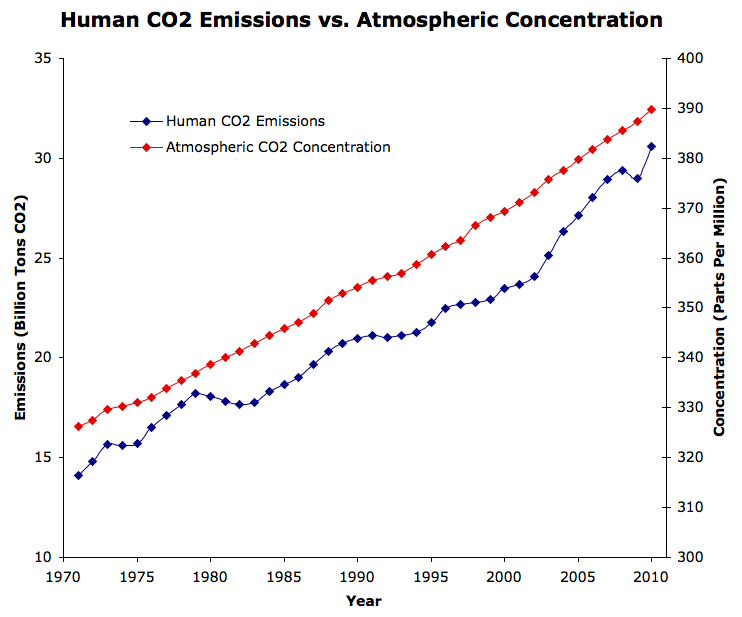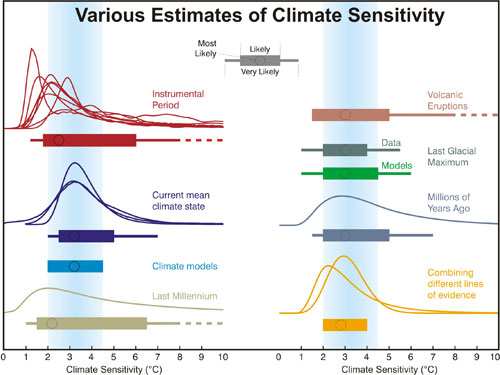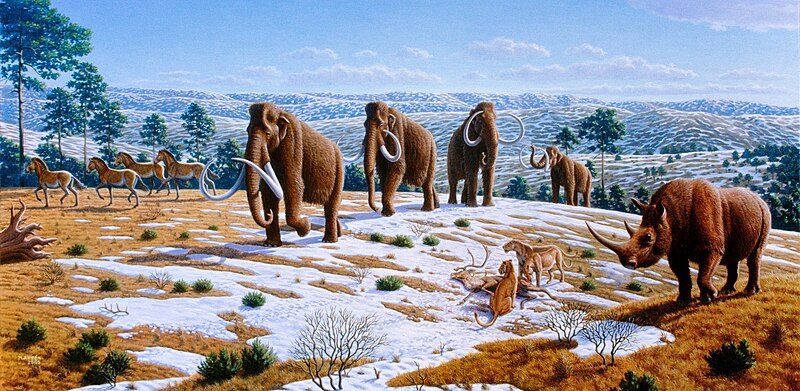(Fahrenheit) 451 ppm
Posted on 11 December 2011 by Bob Lacatena
A Chilling Thought
The recent Schmittner paper on equilibrium climate sensitivity, estimated by using a simple climate model and a comparison with the Last Glacial Maximum, led me to a new and thought-provoking perspective on exactly what man is doing. One can use an even simpler model — a simple rule of thumb — to frame exactly what is happening and what we might expect. One need not even go as far as a simple computer climate model to arrive at an unsettling conclusion.
Scientists have attempted to define a minimum safe global mean temperature increase, above which we are really taking our chances and rolling the dice. To stay within this they have computed a threshold of CO2 levels beyond which we should not go. Based on a best estimate of climate sensitivity of 3?C per doubling of CO2 and a target temperature increase of 2?C, the CO2 target level is 450 ppm.
But 451 ppm is just as important a number.
Of Knobs and Levers
CO2 is termed the Earth's biggest control knob. It hadn't been until now, because a knob implies something that someone can turn to control things. In a normal, natural world and on relatively short timescales, say tens of thousands of years, carbon dioxide is interlocked with global mean temperature and other variables. Temperatures can drive carbon dioxide levels up or down, which in turn drive temperatures further up or down.
Carbon dioxide acts as a feedback that enhances temperature changes.

Figure 1: Vostok ice core records for carbon dioxide concentration and temperature change.
This is most obvious during the transitions between glacial and interglacial periods, when temperatures rise or drop and CO2 seems to follow along like a happy puppy. What is not obvious when looking at the readings is that while orbital forcings cause the initial change in temperatures, and CO2 levels rise or fall in accordance with that initial change, the subsequent temperatures themselves also rise and fall in accordance with the changing CO2 levels.
The basic formula behind a glacial termination is that something (orbital forcings) starts the increase in temperature. Actually, what really starts it is a change in the length and severity of northern hemisphere summers, without changing the overall amount of radiation reaching the planet at all. That stays fairly constant.
These seasonal changes in turn cause the ice sheets covering the northern hemisphere land masses to begin to melt. This reflects less sunlight back into space, and that really does change the amount of energy that the planet receives from the sun, which leads to warming. It also results in the release of methane, another powerful greenhouse gas, which warms the planet even further.
Then CO2 kicks in. The oceans warm. Warmer water cannot hold as much dissolved carbon dioxide and so the oceans release some CO2 into the atmosphere. CO2 in the atmosphere causes warming. The increased warming causes the ice sheets to retreat further, and the oceans to warm further, and more CO2 to be released.
This continues, but with limits. There is (or had been) only so much CO2 that could make its way into the atmosphere. The system only pushes this cycle so far. The many previous glacial terminations in the past 2.5 million years (a period known as the Pleistocene Epoch) have seen lows of about 180 ppm of CO2, and highs between 250 ppm and 300 ppm.
The main point is that temperatures and CO2 are interlocked, or at least had been until now. Temperature changes had to get the ball rolling, so on a graph they will lead the way, but the two work in concert. One is not pulling a leash to drag the other along. They each push and pull the other, working their way from low to high, or high to low, as an integrated system.
CO2 does not "lag" temperature. That's a simplistic, inaccurate and indiscriminate view of a complex interaction.
Turning the Knob
Unfortunately, contrary to recent natural history, man has learned how to remove the regulator and to dial up a far higher level of CO2 in the atmosphere. CO2 has become the climate's biggest control knob in the last two centuries or so, in the sense that it is in fact a control that mankind can twist, turn, tweak and, sadly, overdo.
A glacial termination happens on very, very long timescales relative to man. What we have done in the past two centuries, however, applies a change to CO2 levels — implying an equivalent change in climate — that would otherwise take nature 10 to 12 thousand years.
CO2 was once interlocked with temperature. In the past 200 years we have instead taken 337 gigatonnes of carbon out of the ground and injected it into the atmosphere and the oceans. Nature spent the better part of several hundred million years converting that carbon into new forms (coal, oil, gas) and sequestering it deep under the surface of the earth.

Figure 2: Human CO2 emissions (blue, left y-axis, Source: IEA) vs. atmospheric CO2 concentration (red, right y-axis, Source: Mauna Loa record)
Man will be able to undo in 200 years what took nature hundreds of millions of years to accomplish, and in so doing, in that same time frame, we are duplicating a feat that normally takes nature 10,000 years to accomplish (i.e. increasing atmospheric CO2 levels by two thirds).
And, as an important point, we have no idea if we are capable of duplicating nature's feat of again sequestering that carbon underground. We have far too easily turned the knob in one direction, but with no capacity whatsoever to turn it in the other.
An Ice Age
For the past two and a half a million years this planet has been locked in an Ice Age, the Pleistocene Epoch, during which the poles are always covered with ice caps. During glacial periods those ice caps extend much further down in the northern hemisphere, covering much of the land and oceans above the 34th parallel. During interglacial periods, such as the one we are in now, the globe warms, the ice retreats and life gleefully expands to fill the space that opens up.
The common man on the street, however, uses the term "ice age" to refer to that glacial period where the permanent (year round) ice sheets extend as far as Michigan, Ohio, and Germany.
The transition out of such an "ice age" to our current world involves an appropriate temperature increase and an interlocked change in carbon dioxide from 180 ppm to 285 ppm. It took an increase of 105 ppm, or a factor of 1.6, to get us from an "ice age" into the world in which we currently not only live, but thrive.
We have now, as a matter of the natural development of our own civilization and technology, unlocked vast stores of carbon that have been unavailable to the system throughout the Pleistocene Epoch.
By releasing that carbon — by burning fossil fuels and converting the long carbon chains into carbon dioxide — we have dramatically altered the system. For 2.5 million years it has been seemingly impossible to naturally raise CO2 levels above 285 ppm. It hasn't happened in dozens of glacial terminations.
We are now at 390 ppm and rising at an average of 2 ppm per year.
Imagine if we were to apply the same change to our world as was required to shift the planet from a glacial to an interglacial period (or in incorrect but layman's terms, from an "ice age" to our current climate). What if we were to raise CO2 levels from 285 ppm by an equivalent factor of 1.6?
That would mean raising CO2 levels to 451 ppm.
We're at 390 ppm now. Moving from 390 ppm to 451 ppm is a change of a mere 61 ppm. At the current rate of 2 ppm per year, with no further growth in emissions, that means we will reach 451 ppm in just 31 years. By 2042 — by the time a 2 year old today turns 33 — we will have released forces equivalent to the transition from glacial period to an interglacial, from an "ice age" to our current "green age."
A Fire Age
What, then, will this new age, the one that follows our "green age," look like? Various efforts at modeling and climate science attempt to develop a clear picture of the ecosystem, climatic and weather changes that will result, but while it may be important to anticipate the details, the final answer in a more general sense must at the minimum be very different from the world in which we live now.
If, in common parlance, a glacial period is termed an "ice age," while the world we live in today might be termed a "green age," then I would suggest that we are now heading into a "fire age."
Deserts are expected to expand with the growth of the Hadley Cells. Droughts and wild fires are expected to increase. Crops will be less productive. Sea levels will rise as more and more ice melts.
During the Eemian, an interglacial period that began roughly 130,000 years ago and lasted 16,000 years, temperatures in Europe north of the Alps were roughly 1-2?C higher than today. Sea levels were 4 to 6 meters higher. CO2 levels were roughly at 300 ppm.
Going further back, during a warm period 3 million years ago within the Pliocene epoch, temperatures were a mere 2-3?C warmer than today (see here and here and here). Sea levels were 25 meters higher. CO2 levels were between 360 ppm and 400 ppm.
How much will the world change if we increase CO2 levels to 451 ppm? Time will tell, but one way or the other we may be duplicating in strength in just 200 years what nature itself requires 10,000 years to do. We are applying that forcing beyond the point at which nature has always stopped.
We are duplicating within that short time period the greatest single force on this planet that nature alone has wielded for the past 2.5 million years. But nature does so slowly, carefully and predictably.
We are doing so rapidly, erratically, and without awareness or understanding of the consequences, or even taking long enough to recognize that what we are doing does indeed have an irreversible effect.
A Fire Extinguisher
There are some important points to make to temper this realization.
The first is to recognize that in a glacial termination there are forces at work that are not present in today's world. The retreat of the vast ice sheets account by some estimates for 54% of the global temperature change during glacial termination. These changes in ice sheets also have huge effects on ocean currents which in turn affect climate.
In today's world, with ice only covering much smaller areas at the poles, that particular influence on climate change is greatly reduced. As such we should not expect the same response in temperature, and hopefully in overall climate change, with the same relative increase in CO2.

Figure 3: Various estimates of climate sensitivity (Knutti and Hegerl 2008).
On the other hand, this is a new paradigm and one without equal in natural history. During a glacial termination, the spread of vegetation actually helps to hold CO2 levels down by drawing it out of the atmosphere and using it for plant growth as the forests of the world reclaim the land once covered by glaciers and ice. In our world, if things get too bad, huge swaths of vegatation may die, for instance if the Amazon rain forests turn in whole or in part into savanna or if the deserts of the world expand due to changes in precipitation patterns and the growth of the Hadley Cells. This will have the opposite effect, adding even more CO2 to the atmosphere rather than drawing it down.
It's difficult to predict where things will go. That's what science and climate models and paleo studies are all trying to determine. There is some reason to hope that the overall temperature and climate change will not be dramatic, but there's also good reason to believe that the effects will be more than strong enough to adversely affect billions of lives.

Figure 4: Now extinct fauna from the last glacial period in Northern Spain (image courtesty Wikipedia Commons).
Decades, Centuries or Millenia
Another major difference is that in the case of a glacial termination the changes in both temperatures and CO2 levels are very, very slow, taking more than 10,000 years, and changing continuously in concert.
In our situation we have ratcheted up the CO2 levels in a blink of an eye from nature's perspective. In 1800 CO2 levels were approximately at 285 ppm. By 1900 they were closer to 290 ppm. As of 2010 they were at 390 ppm and rising fast.
So how fast will temperatures rise? This is another area of study and debate in climate science. There is a lot of variability in the system. There is a vast amount of water in the oceans capable of absorbing a lot of energy before the planet reaches a new equilibrium temperature. The ultimate, final equilibrium temperature also depends on feedbacks, and those kick in at different rates. How quickly will the Amazon transition to savanna, if at all? How quickly will deserts expand? How much natural CO2 will be released and add to anthropogenic sources? How great and how important will the melting of Artic ice become? How much methane will be released, and how quickly, from the permafrost regions of the Arctic?
We will reach 451 ppm at the current rate by 2042, but that doesn't mean we'll change the planet that quickly. By 2042 we will have "set the thermostat" to the new setting, but it could take anywhere from decades to hundreds to thousands of years for the planet to reach its final, new equilibrium temperature. No one alive today will live to see what we have utlimately done to planet.
The one thing we do know is that we are turning the thermostat up with no ability to turn it back down. We are commiting the planet to a 451 ppm scenario with no firm idea of what that is going to mean and absolutely with no ability to draw CO2 levels back down to their natural 285 ppm levels.
450
It is a pure but poignant coincidence that the number discussed here — 451 ppm — is so close to another number that has been bandied about in recent days — 450 ppm.
450 ppm is — given a proposed, best estimate of climate sensitivity of 3?C — the target level of CO2 that we must not pass if we want to maintain a reasonable chance of restraining climate change to a mere 2?C increase. 2?C has been chosen as a maximum "safe" upper bound to avoid truly dangerous climate change. Any increase beyond that is deemed to be, by mere rule of thumb, unacceptable.
|
The math is simple, based on the logarithmic relationship between CO2 levels, climate sensitivity and temperature increase:
In English, this means that given a starting level CO2-initial of 285 ppm, a climate sensitivity (Tsensitivity) of 3?C, and a temperature increase (Ttarget) of 2?C, we arrive at a CO2-target of 450 ppm.
|
Sadly, we may well find that even 2?C itself is quite far from acceptable.
451 ppm is, as explained here, the forcing that implies a change from our current climate, a "green age," to a new and foreign world, just as it accompanied a change from an "ice age" (i.e. a glacial period) to our current climate. That forcing caused a change in global mean temperatures of 3?C to 5?C, and completely recast the surface of the planet from one of sheets of ice to flourishing green.
One does not need a fantastic education in science or climate science to make a fairly basic, rule of thumb observation of where we may be headed.
One has to look at the similarity in these two numbers, 450 and 451, and wonder if nature isn't, in some small, intelligent-design kind of way, trying to tell us something.

Figure 5: Target CO2 levels.































 Arguments
Arguments























 0
0  0
0 Cross-correlations (covariances): The blue curve is temperature and CO2, the red curve is temperature and CH4, and the green curve is CO2 and CH4.
Here is an English translation of Byalko's discussion of that figure in the paper referenced above: "The cross-correlations (covariances) of these variables give even more information. They are presented with a higher time resolution because the shift of the maxima of these functions forward or backward from zero indicates which variable is leading, which is lagging, and with what characteristic time. As Fig. 3 shows, temperature and [CO2] are closely coupled at small times with a maximum covariance equal to 0.88 reached with the temperature leading by about 2 ky relative to [CO2](t). The accuracy of calculating lags and leads, regrettably, is not yet good, being around 0.5 ky. The temperature and methane concentration turned out to be almost synchronous, but their maximum covariance is lower, equal to 0.82. Finally, CO2 concentration lags behind [CН4] with a 1.5 ky average lag; their maximum covariance is equal to 0.74. The logic of this time lag can be explained by the process of oxidizing methane into carbon dioxide."
Methane release from Arctic permafrost was probably not involved in past major warming episodes, at least not until the Arctic ice sheet had receded. It seems likely to me the significant increase in atmospheric CH4 preceding those warming episodes involved releases from the benthic methane hydrate stores. So now I have the question (which can only be answered speculatively at the present): What if the CO2-induced warming leads to release of CH4 from both benthic and permafrost stores? Would this lead to a major warming episode, of which several have occurred in the past 800,000 years, but starting this time from a warm interglacial plateau and not from the depths of a deep ice age?
One research project has been involved in trying to find related answers. I quote a couple passges, one long and one short, from their webpage. The long passage: "This effort will develop, for the first time, a tool for the systematic quantification of the potential impact of dissociating marine hydrates on the global climate. The results of this study will be important in testing the validity of the Clathrate Gun hypothesis, and the corollary hypothesis that rapid hydrate dissociation can have a cascading effect resulting in enhanced hydrate dissociation and accelerating global warming, with potentially catastrophic physical and economic consequences."
The short passage: "Current Status (November 2011): All project research has been placed on hold due to ongoing funding issues."
Cross-correlations (covariances): The blue curve is temperature and CO2, the red curve is temperature and CH4, and the green curve is CO2 and CH4.
Here is an English translation of Byalko's discussion of that figure in the paper referenced above: "The cross-correlations (covariances) of these variables give even more information. They are presented with a higher time resolution because the shift of the maxima of these functions forward or backward from zero indicates which variable is leading, which is lagging, and with what characteristic time. As Fig. 3 shows, temperature and [CO2] are closely coupled at small times with a maximum covariance equal to 0.88 reached with the temperature leading by about 2 ky relative to [CO2](t). The accuracy of calculating lags and leads, regrettably, is not yet good, being around 0.5 ky. The temperature and methane concentration turned out to be almost synchronous, but their maximum covariance is lower, equal to 0.82. Finally, CO2 concentration lags behind [CН4] with a 1.5 ky average lag; their maximum covariance is equal to 0.74. The logic of this time lag can be explained by the process of oxidizing methane into carbon dioxide."
Methane release from Arctic permafrost was probably not involved in past major warming episodes, at least not until the Arctic ice sheet had receded. It seems likely to me the significant increase in atmospheric CH4 preceding those warming episodes involved releases from the benthic methane hydrate stores. So now I have the question (which can only be answered speculatively at the present): What if the CO2-induced warming leads to release of CH4 from both benthic and permafrost stores? Would this lead to a major warming episode, of which several have occurred in the past 800,000 years, but starting this time from a warm interglacial plateau and not from the depths of a deep ice age?
One research project has been involved in trying to find related answers. I quote a couple passges, one long and one short, from their webpage. The long passage: "This effort will develop, for the first time, a tool for the systematic quantification of the potential impact of dissociating marine hydrates on the global climate. The results of this study will be important in testing the validity of the Clathrate Gun hypothesis, and the corollary hypothesis that rapid hydrate dissociation can have a cascading effect resulting in enhanced hydrate dissociation and accelerating global warming, with potentially catastrophic physical and economic consequences."
The short passage: "Current Status (November 2011): All project research has been placed on hold due to ongoing funding issues."
 I think the odds are stacked very heavily against Texas, Southern California, Mexico, Spain, Italy, the Balkans, Israel, Egypt, South America and others. Large parts of the northern USA, Canada, far northern Europe, Asia and others may well see a greener world. But some very basic parameters look to combine to make those particular changes fairly likely.
Everyone is going to experience the upheaval of change, however, and that is the main point. The world is going to change, probably more quickly than people expect, and that is going to be both expensive and painful (in a real, personal sense for too many people). It doesn't really take much beyond common sense to look at things at a high level and to say that it is not worth the risk. Not when inexpensive, coordinated, moderate action now is capable of keeping the situation under control with far less expense than is seemingly inevitable given a continuing course of almost inaction.
From the perspective of actual, living people and today's civilization, the term "Fire Age" may well seem appropriate.
I think the odds are stacked very heavily against Texas, Southern California, Mexico, Spain, Italy, the Balkans, Israel, Egypt, South America and others. Large parts of the northern USA, Canada, far northern Europe, Asia and others may well see a greener world. But some very basic parameters look to combine to make those particular changes fairly likely.
Everyone is going to experience the upheaval of change, however, and that is the main point. The world is going to change, probably more quickly than people expect, and that is going to be both expensive and painful (in a real, personal sense for too many people). It doesn't really take much beyond common sense to look at things at a high level and to say that it is not worth the risk. Not when inexpensive, coordinated, moderate action now is capable of keeping the situation under control with far less expense than is seemingly inevitable given a continuing course of almost inaction.
From the perspective of actual, living people and today's civilization, the term "Fire Age" may well seem appropriate.







Comments